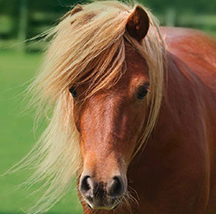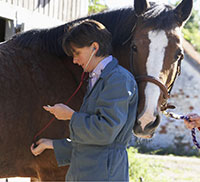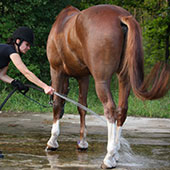
The Top 5 Most Common Health Problems in Horses
With over 1.3 million dogs, cats, rabbits and horses insured and 43 years of experience helping to ensure the health of pets, we reveal the most common health problems affecting horses.
Petplan Equine paid out over £13 million in claims in 2019. Find out the top 5 most common health problems affecting horses, how to spot the signs and top tips for horse owners below.
The Top 5 Most Common Health Problems in Horses

Fact
Petplan Equine paid out over £845,000 in claims for arthritis in 2019
What is it?
Osteoarthritis, also known as Degenerative Joint Disease (DJD), is common in horses, humans, dogs and many other animals. It's a slowly developing disease in which the joint tissues become inflamed and the joint cartilage is damaged and worn down. Arthritis is very painful and reduces the range of movement in the affected joint.
What are the clinical signs?
- Stiffness
- Swelling of affected joints so they appear larger
- Heat in the joints
- Lameness
How can I help prevent arthritis in my horse?
Osteoarthritis is caused by "wear and tear" over a number of years, most usually in those horses that have had regular "hard work". Below are some tips to reduce the likeliness of arthritis in your horse.
- Take time warming up and cooling down after exercise
- Ride on varied surfaces not too much on hard ground or very deep surfaces
- Monitor your horses weight, obesity increases pressure on the joints
What can I do if my horse is suffering?
- There is no absolute cure for osteoarthritis but there are a number of ways of managing the condition and reducing the pain it causes.
- Your vet may suggest an oral joint supplement or a direct injection to the affected joints in addition to oral anti-inflammatory drugs
- In conjunction with advice from your vet, a light exercise programme tailored to maintain suppleness can be very beneficial
- Keep your horse turned out as much as possible as moving around reduces the likelihood of stiffening up

Fact
Petplan Equine paid out over £1 million in claims for gastric ulcers in 2019
What is it?
Gastric Ulcers are generally small erosions in the lining of the stomach which are painful and can affect the appetite, appearance, demeanour and riding experience of your horse.
What are the clinical signs?
These are many and varied. Painful areas in the lining of the stomach means:
- Your horse's appetite may be reduced or inconsistent and that he may prefer hard feed to hay as the long fibre can traumatise the ulcers and cause pain
- Constant pain in the stomach can cause low grumbling colic, especially after eating
- The coat can become dull
- The horse’s temperament can change and he can become subdued and tetchy
- Ridden exercise can cause the stomach acid to splash onto the ulcers causing paid this can be misinterpreted as a lameness, naughtiness or back pain
How can I help prevent Gastric Ulcers?
Gastric Ulcers are most commonly associated with psychological stress and therefore minimising this offers the best assurance your horse will not develop them. Make sure your horse is not going for prolonged periods without food, that it is turned out on a daily basis and in a field with other horses with whom it 'gets along', that his exercise regime is measured and consistent and that any changes to management or exercise are phased in gradually and not drastically. Feeding a high proportion of the diet as forage also ensures the acid in the stomach is buffered in contrast with excessive quantities of hard feed which predispose to high acid levels and accordingly damage to the stomach lining.
What can I do if my horse is suffering?
Diagnosis of gastric ulceration is made by your vet performing a gastro scope. A scope is passed down the food pipe to look at the stomach lining. Management and feeding adjustments should be made as your vet advises and your horse will be put on a daily dose of Omeprazole, an excellent treatment that can lead to a full resolution of the ulcers within 4 weeks.

Fact
Petplan Equine paid out over £475,000 in claims for colic in 2019
What is it?
Colic is the name given to abdominal pain in horses. Ranging from a mild stomach ache to a displacement or twist in the intestine requiring lifesaving surgery, colic is one of many horse owner’s biggest concerns.
What are the clinical signs?
- Pawing or scraping the ground
- Turning to look at the abdomen (‘flank watching’)
- Restlessness - getting up and down frequently
- Frequent attempts to urinate
- Rolling
- Increased pulse and high temperature
How can I help prevent equine colic?
- Feeding – Make sure your horse has a constant supply of fresh water and feed little and often. If you need to change your horse's feed make sure you introduce this gradually
- Health care – make sure your horse has regular health checks, follow an appropriate worming program, poo pick the paddocks at least once a week and ensure he has regular dental health checks
- Routine – keep your horse happy and stress free by avoiding changes to his routine. Make sure he gets enough down time in the field and relaxing hacks in addition to his schooling programme
What can I do if my horse is suffering?
- If you suspect your horse has colic it’s important to call your vet. Horses with mild colic may benefit from being walked out in the school or paddock while you are waiting for the vet to arrive as it can distract the horse from the pain. If your horse wants to get down, or even roll, then let him - the situation will not be helped by you sustaining an injury trying to keep him walking
- For more information on your horses digestive system take a look at our colic guide and video from equine vet Gil Riley

Fact
Petplan Equine paid out over £420,000 in claims for laminitis in 2019
What is it?
Laminitis, a painful and debilitating condition affecting the horse's feet. Laminitis means inflammation of the laminae, a soft tissue structure found in the hoof.
What are the clinical signs?
- Lameness
- Heat in the hoof and surrounding areas
- Increased digital pulses in the affected feet
- Sometimes it is so distressingly severe that the affected animal cannot stand
How can I help prevent laminitis in my horse?
- Monitor your horse’s weight and feed him accordingly. An obese horse or pony is more likely to suffer from laminitis
- Avoid fast work on hard ground; concession to the hoof is a contributor to laminitis
- If your horse is suffering from laminitis a blood test for Cushing’s disease is recommended, especially if the horse is 10 years or older
What can I do if my horse is suffering?
- Your vet will advise box rest with a deep bed and a low calorie diet. Laminitis horses are also often prescribed special shoes
- For more lameness advice from Petplan Equine visit our lameness pages

Fact
Petplan Equine paid out over £725,000 in claims for desmitis in 2019
What is it?
Desmitis in horses is a condition owners may be less familiar with. However; horses suffering from this condition is surprisingly high. Desmitis means inflammation of a ligament, usually in the limbs where it is a common cause of lameness. The three most common ligaments inflamed are the suspensory ligament, the check ligament and the collateral ligaments of the coffin joint.
What are the clinical signs?
The top tip is to "know your horse"; Suspensory desmitis can often "creep up" without obvious lameness. If your horse's behaviour or performance changes (he becomes better on one rein, transitions are not so smooth or his back becomes tense) these are signs that he may have suspensory desmitis in the hind limbs.
How can I help prevent my horse suffering from desmitis?
- Strengthen your horse’s ligaments by including regular straight line work on a hard surface. Discuss this with your vet or trainer to establish an appropriate amount of this work for your horse, as over doing it can also be a risk
- Good foot balance is essential; if you or your farrier are unhappy with your horses feet, then a set of foot balance x-rays can be helpful in assisting your farrier’s approach
What can I do if my horse is suffering?
- Once diagnosed there are various treatments for desmitis depending on the severity and cause of your horses swelling. Box rest with a disciplined walking out programme for 6-8 weeks is the most common start to the rehabilitation process.
- Correction of any foot imbalance issues is vital and remedial shoeing is often required in those horses with collateral desmitis of the coffin joint
- How good are you at spotting a lameness? Test your skills with our trotting up videos
For more tips and advice on caring for your horse visit the Petplan Equine Horse Advice tab.




